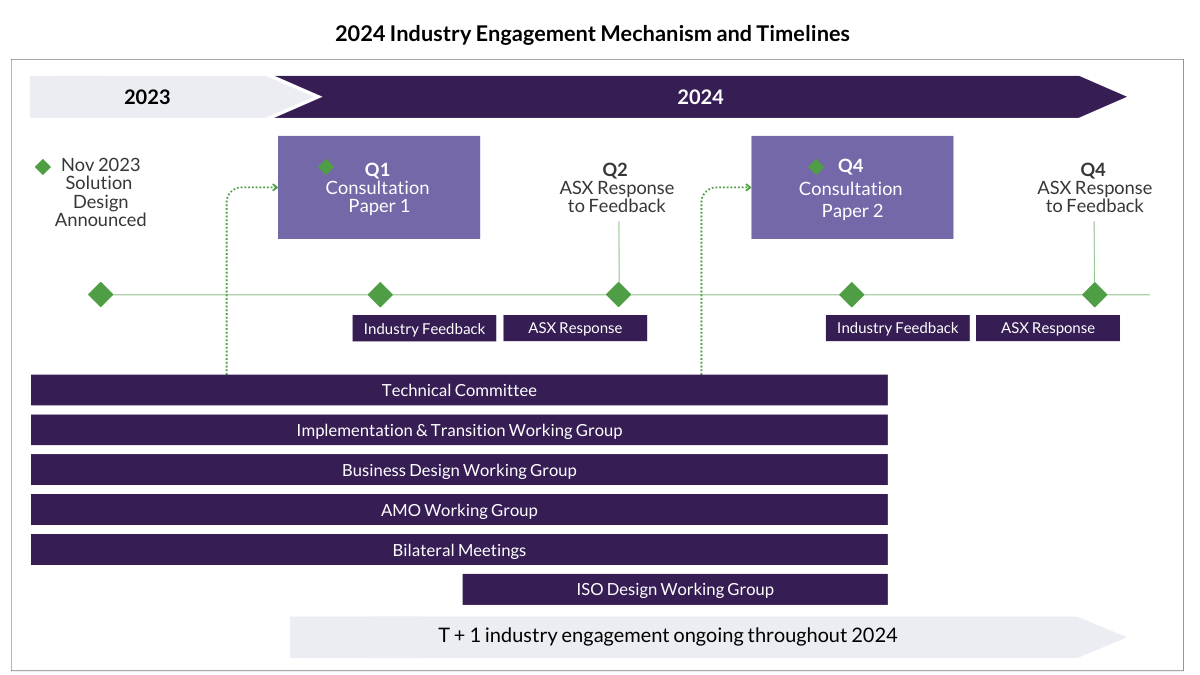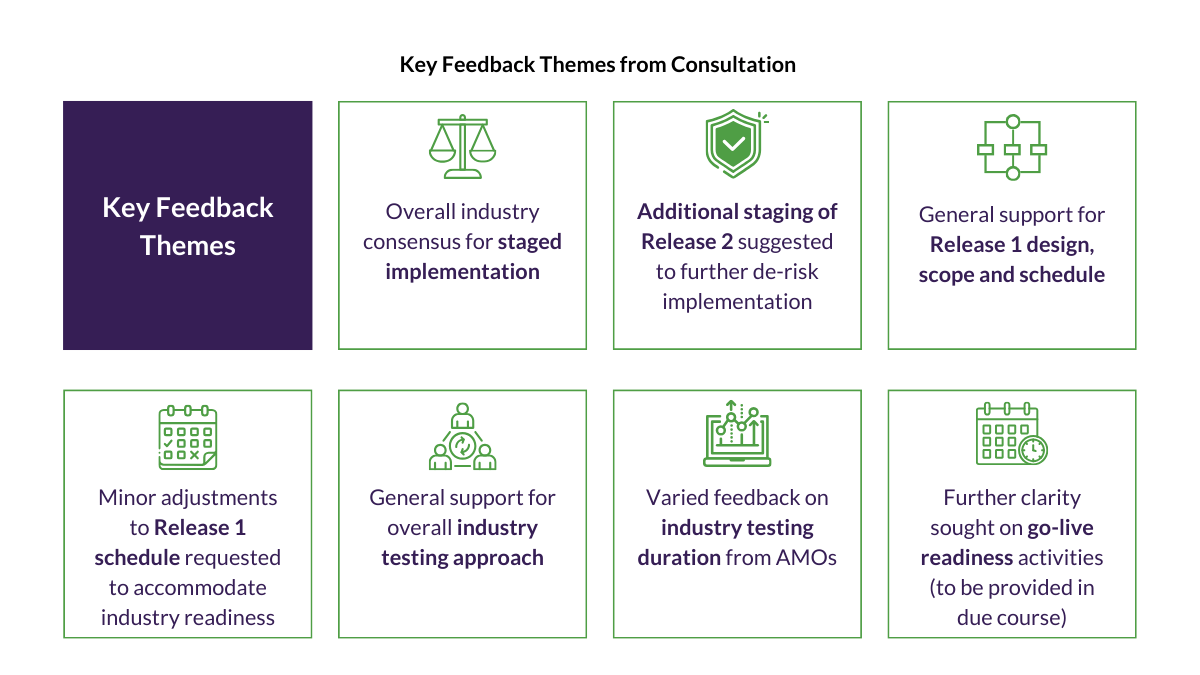Introduction
This article will provide an overview of the proposed replacement of the CHESS infrastructure and the possibility of reducing settlement cycle times from T+2 to T+1, summarising the relevant consultations to date and exploring the possible implications for the managed fund and listed security environments. This article will draw insights from international experiences, particularly the recent transition to T+1 settlement in the United States.
Chess Replacement Project
Background and Objectives
The primary objectives of the CHESS Replacement Project include:
- Upgrading the technology platform to enhance system resilience and security.
- Improving operational efficiency and reducing costs for market participants.
- Enabling faster innovation and the introduction of new services.
- Ensuring compliance with evolving regulatory requirements.
Project Timeline and Challenges
The CHESS Replacement Project has faced several challenges and delays since its inception, which include:
- Initially slated for implementation in April 2021, the go-live date was postponed multiple times due to various factors, including the COVID-19 pandemic and technical issues.
- In November 2022, ASX announced a significant setback, revealing that the current solution design and implementation approach would not meet the market’s high standards of scalability and resilience.
- Following this announcement, ASX initiated an independent review of the project to reassess the path forward.

Source: ASX CHESS Replacement: Release 1 Consultation (p.6)
Current Status and Future Direction
As of July 2024, the ASX CHESS Replacement Project is undergoing a comprehensive reassessment. Key developments include:
- ASX has engaged with market participants, regulators, and technology experts to gather feedback and insights on the best approach moving forward.
- The focus has shifted towards exploring alternative solutions that can meet the market’s requirements for stability, scalability, and innovation.
- ASX is working closely with the Australian Securities and Investments Commission (ASIC) and the Reserve Bank of Australia (RBA) to ensure regulatory compliance and maintain market integrity throughout the transition process.
T+1 Settlement Proposal
Introduction to T+1 Settlement
On 28 June 2024, the ASX released a much-anticipated Response Paper to its earlier 14 March 2024 CHESS Replacement Consultation Paper, focussed on the proposed staged implementation approach of the new CHESS replacement system. The Response Paper set out the design, scope, schedule and testing approach for Release 1 (Clearing).1

Source: ASX Response to Consultation Feedback: CHESS Replacement Release 1 Consultation (p.3)
ASX Industry Whitepaper on T+1 Settlement
On 23 April 2024, the ASX published an industry Whitepaper around potential changes to the current settlement landscape in Australia. The ASX Business Committee and T+1 Working Group are canvassing the many potential impacts of settlement cycle compression and strategic considerations around a potential transition to T+1. A summary of next steps is expected in August 2024. Key points from the Whitepaper include:
- Rationale: The move to T+1 aims to reduce systemic risk, improve operational efficiency, and align Australia with international best practices.
- Timeline: While specific dates are not yet confirmed, ASX proposes a phased approach to implementation, allowing market participants sufficient time to adapt their systems and processes.
- Scope: The T+1 settlement cycle would apply to most ASX-listed securities, including equities, corporate bonds, and exchange-traded products.
- Challenges: The Whitepaper acknowledges potential challenges, such as the need for increased automation, changes to batch processing schedules, and impacts on cross-border transactions.
- Benefits: Expected benefits include reduced counterparty risk, improved liquidity management, and potential cost savings for market participants.
Regulatory Perspective
ASIC and the RBA have shown support for the T+1 initiative while emphasising the need for careful planning and industry-wide collaboration. In a joint letter dated August 2023, ASIC and the RBA outlined their expectations for the transition process:
- Comprehensive risk assessment and mitigation strategies.
- Clear communication and engagement with all stakeholders.
- Robust testing and simulation exercises to ensure market readiness.
- Consideration of the broader market ecosystem, including custodians, share registries, and international participants.
Implications For Managed Funds And Listed Environments
In examining the case for shorter settlement cycles the ASX has noted that, despite the many international similarities, key differences in the Australian market will require specific consideration of the benefits and risks / costs of transitioning to T+1.
The cost-benefit evaluation for T+1 will go through a sequential process of consideration and is expected to evolve as the ASX weighs the risks to Australia of being ‘left behind’ staying on T+2 that would make us a less attractive destination for global investment.
Managed Funds
The transition to T+1 settlement is expected to have significant implications for managed funds:
- Operational Changes: Fund managers will need to streamline their processes for trade confirmation, reconciliation, and cash management to meet the shortened settlement timeline.
- NAV Calculation: The compressed timeframe may require adjustments to Net Asset Value (NAV) calculation processes, potentially impacting fund pricing and reporting.
- Liquidity Management: Funds may need to reassess their liquidity strategies to ensure sufficient cash is available for settlement within the T+1 timeframe.
- Cross-Border Considerations: For funds with international holdings, the misalignment between T+1 in Australia and potentially longer settlement cycles in other markets could create additional complexities.
Listed Environments
For listed entities and their shareholders, the move to T+1 settlement presents both opportunities and challenges:
- Corporate Actions: The compressed settlement cycle may require adjustments to the timing and execution of corporate actions, such as rights issues and dividend payments.
- Shareholder Communications: Listed companies and their share registries may need to enhance their communication systems to ensure timely dissemination of information within the T+1 timeframe.
- Retail Investor Participation: The shorter settlement cycle could potentially impact retail investor participation, particularly for those relying on traditional banking channels for fund transfers.
- Market Liquidity: T+1 settlement is expected to improve overall market liquidity, potentially benefiting listed companies through increased trading volumes and more efficient price discovery.
Lessons from the U.S. Transition to T+1
The United States successfully transitioned to T+1 settlement on May 28, 2024. This experience offers valuable insights for the Australian market:
- Industry Collaboration: The U.S. transition highlighted the importance of coordinated effort across all market participants, including exchanges, clearing houses, broker-dealers, and custodians.
- Technology Investment: Significant investments in technology and automation were required to meet the compressed settlement timeline.
- Operational Adjustments: Market participants had to revise their operational processes, including trade matching, affirmation, and allocation procedures.
- Global Implications: The U.S. move to T+1 has accelerated discussions in other major markets, including Europe and Asia, about shortening their settlement cycles.
Conclusion
At BoardRoom we remain agile, continue to invest in technology and process improvements while we maintain open lines of communication with our clients, regulators and industry partners. We will continue to provide our stakeholders with continuous updates as the CHESS Replacement Project and proposed transition to T+1 settlement progresses.
Contact BoardRoom for more information:
Tharun Kuppanda
Head of Risk, Compliance and Regulatory Partnerships
tharun.kuppanda@boardroomlimited.com.au+61 2 8016 2890
